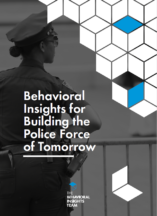Key findings
- To attract more—and more diverse—applicants, departments must change how they advertise police jobs to speak to motivations other than public service. Tweet
- Attracting applicants isn't always enough. Cities also need to streamline the hiring process to keep more applicants engaged and quickly move them through to training. Tweet
- Your next recruit may not be where you're looking. Reaching out to residents who have shown prior interest in public service might prove more effective. Tweet
Attracting great candidates from diverse backgrounds is crucial to building a government workforce that can serve communities effectively and build trust among residents. This need is especially urgent in law enforcement agencies, where there has been a renewed focus on how to attract and retain candidates, especially those from backgrounds that are currently underrepresented within the police. Police forces are often working with tight budgets, strong unions, and political pressures. These factors make structural solutions, such as redefining job roles or changing pay and benefits, extremely difficult. To make an impact today, many agencies are in need of a different set of solutions that can correctly identify and convert latent interest from prospective applicants within the existing constraints of the job.
In this report we share the results of work with 21 US jurisdictions to understand the motivations of those currently in the police force and to apply lessons from the science of human decision-making to the process of attracting and recruiting new police officers. From deciding to express interest in a job to showing up for testing to assessing candidates fairly, the recruitment process involves a number of decision points that can make or break successful hiring. This report aims to demonstrate how behavioral insights can be applied to improve police recruitment and to share the lessons we have learned from this work.








